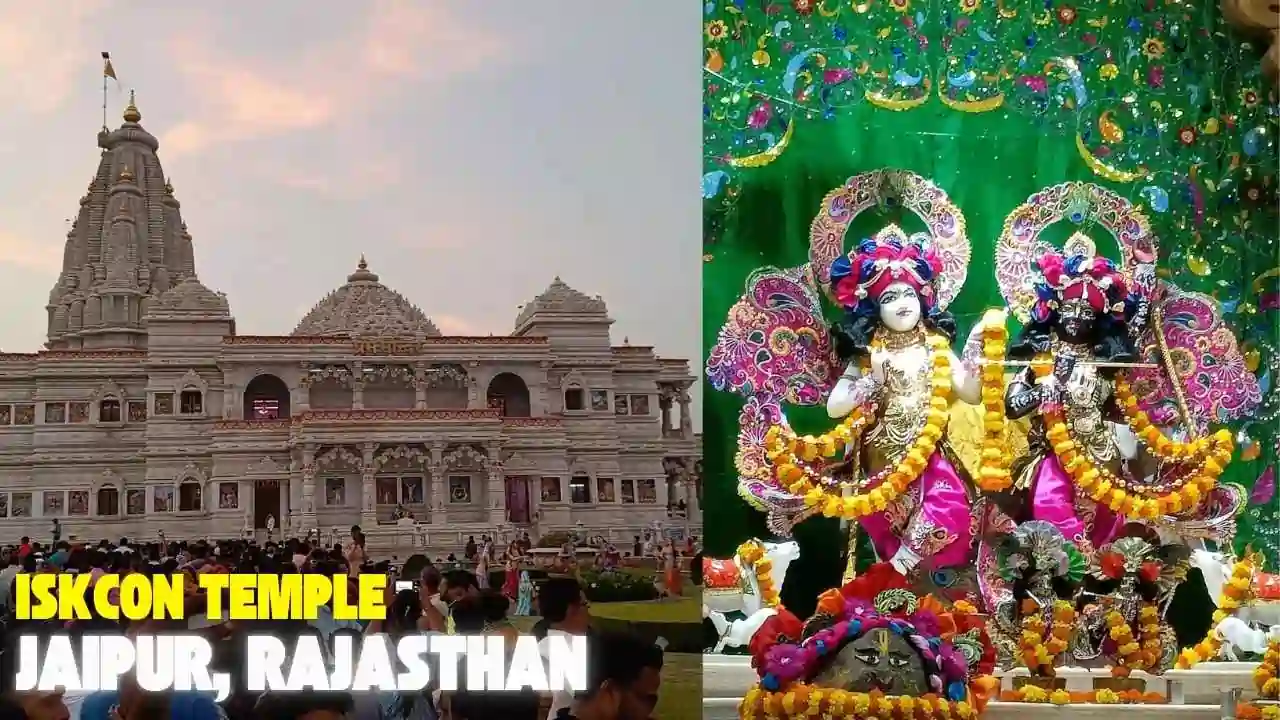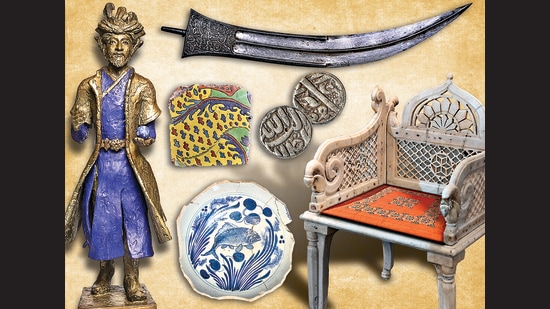
Tales from the crypt: An exclusive preview of Delhi’s new Mughal museum
8 months ago | 111 Views
Nestled in a corner of the pristine Sunder Nursery, across the road from Humayun’s Tomb in central Delhi, a series of red sandstone ramps gently heads to the grassy ground beneath. They descend into corridors and halls with massive sheesham doorways that summon the grandeur of Fatehpur Sikri’s Buland Darwaza. Inside, await five huge galleries of granite flooring, marble columns, and stone benches.
Delhi is crusted with layers and layers of the past. These exist laterally, extending outwards, but also vertically, beneath the ground, under a surface that millions of feet pound on every day. It is fitting, then, that the newest landmark of this city of graveyards is entirely underground.
Opening in August, the Humayun Museum lies beneath the soil on which the Mughal identity, which gave a distinctive character and left an indelible mark on India, first began to take shape. Indeed, the earliest city of the Mughals was not Agra, or Lahore, or Fatehpur Sikri. Neither was it the Walled City of Shahjahanabad, the so-called Purani Dilli. It was around the much older 14th century shrine of Delhi’s great Sufi saint Hazrat Nizamuddin Auliya. This is the assertion of the country’s newest museum.
“The Humayun Museum will serve as a gateway to the UNESCO World Heritage Site of Humayun’s Tomb,” says Ratish Nanda, the CEO of Aga Khan Trust for Culture, which has built the museum. “Each artefact relays and interprets the story of this historic precinct, where 700 years of monumental architecture is surrounded with craft, music, culture, and pluralism.”
Stepping inside the museum, visitors are transported into the world of Humayun’s Tomb — from the 16th century, when the monument was built, to the later centuries whose narrative the tomb helped shape, right up to this modern age. Each galley is arrayed with numerous clusters devoted to different themes — their arrangement resembling French gardens whose hedges are arranged like a maze. The clusters feature artefacts, replicas, films playing on loop, architectural models, stone fragments, statues and paintings that come together to weave hundreds of years of history.
The Humayun Museum is the culmination of 15 years of work by the Aga Khan Trust for Culture, in partnership with the Archaeological Survey of India — the same team that restored Humayun’s Tomb. Fashioned as a site museum, the subterranean sprawl awakens visitors to the aesthetics of a slice of land that was — due to its intimate proximity to Nizamuddin’s shrine — the preferred burial field for both the awaam and the baadshah (commoner and king). The dargah was venerated by the Mughals all through their 331-year rule. Each of the 18 emperors kept their links with this Sufi terrain; if not always through ziyarat (pilgrimage), then through architecture, or by making the zameen (ground) their final resting place.
Until now, India’s only prominent UNESCO World Heritage Site museum was in Sarnath, which bears a collection of 7,000 precious objects, out of which 300 are on display. The new museum in Delhi exhibits 700 objects, out of which 500 are original — some are provided by the National Museum, and many are from the collection of the Archaeological Survey of India and the Aga Khan Trust. The 200 replicas are of the same dimensions, and in the same materials, as their originals — made by artists trained in the crafts of the time.
For this curtain-raiser, I have shortlisted 10 handpicked exhibits that offer a sense of the museum and capture the era it commemorates.
.
WHERE OBJECTS SPEAK
The inscribed dagger
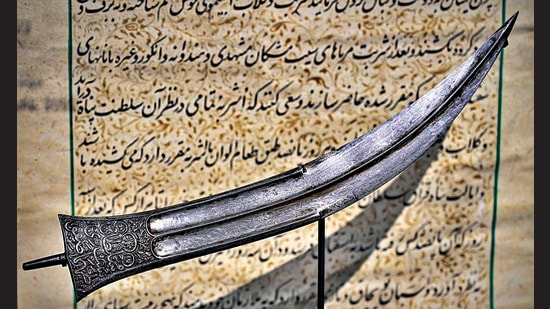
This small weapon helps us understand who Humayun was.
So, who was he?
Humayun’s father Babar founded the Mughal dynasty. Humayun’s son Akbar became the greatest of all the Mughals. Nestled between them, Humayun remains somewhat out of focus. The most famous thing about him is the Humayun’s Tomb — and that wasn’t built by him.
The museum reveals the lesser-known Humayun. Far from being a nonentity, he was a warrior who fought numerous battles, founded the Mughal school of miniature art, lost Hindustan (to Sher Shah Suri) after ruling it for about a decade, and then re-won it 15 years later. During the intervening years, Humayun stayed in Iran for 11 months as a guest of its Shah. And this dagger belonged to the Shah, inscribed with the words: “Sultan Tahmasp Safari”. The iron blade, with its graceful curve, is a tangible link to a long, tumultuous period in Humayun’s life. A life full of contrasting probabilities that could have spun our national history to one of several “what if” alternatives.
.
The grand throne
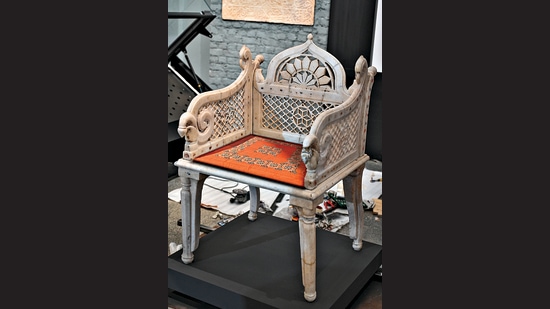
On this, he must have sat and mulled upon the end of his dynasty. This was the ornate throne of the final Mughal emperor.
At first, Bahadur Shah Zafar’s marble throne looks small, not quite a seat of power. Gradually, it grows on the senses, becoming statelier as one observes it closely. The armrests are supported by latticework in stone. The tip of each armrest curves into stylised swans. Rows of coloured spots appear to mark the places inlaid with gems, though these are traces of severely faded paint.
A devotee of Sufism, Zafar had allotted himself a grave next to the dargah of a cherished Sufi saint in Mehrauli. But his plan didn’t work — following the failure of the 1857 war of independence, in which Indian fighters rejected British rule and chose Zafar as their nominal ruler, the emperor was sent into exile in Rangoon, Burma (now Yangon, Myanmar), where he was eventually buried.
Now, at long last, Zafar finds some posthumous peace in the museum. His throne commands a part of the gallery that celebrates his beloved Sufi mystics. The saint of Mehrauli belongs to the same Sufi order as Hazrat Nizamuddin, the surrounding grounds of whose shrine eventually became the resting place of hundreds of Mughal royals. Called the “dormitory of the Mughals,” Humayun’s Tomb is home to 160 graves, most of them in ground-level vaults.
A display case beside Zafar’s throne details all the Mughal monarchs who visited Nizamuddin’s dargah. Their veneration began in 1526, following Babar’s victory over Ibrahim Lodi. Among the first things that Babar did on entering Delhi was to pray at this dargah. Years later, his son Humayun built his capital of Dinpanah, known as Purana Qila, close to the dargah. Humayun also built a tomb for his mother, Maham Begum — it was even closer to the dargah (and now functions as a traffic island).
Then, Humayun’s successor, Akbar, built a mausoleum for his father close to Nizamuddin’s dargah — the Humayun’s Tomb. One of the two most significant early Mughal monuments, it served the model for the other, the Taj Mahal. The tomb was Zafar’s refuge after he lost to the British in 1857, and it was from here that he was arrested and deported to Rangoon.
.
The book of poems
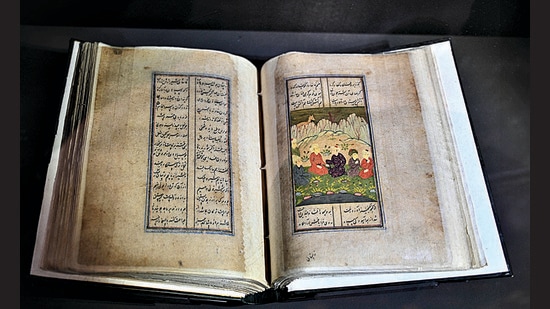
The book is lying open. The left-hand page has Persian text in narrow columns; the page on the right shows a painting of robed men in a garden, with a deer behind the bushes.
This is the 14th century illustrated and handwritten manuscript of the romantic poem Laila Majnu. The version is by the poet Abdullah, who was from Jam town in modern-day Afghanistan. The manuscript has 332 pages of text and 18 illustrations, some bearing floral details in gold. The copy does not belong to Humayun, but its presence reiterates how books were his spiritual companions.
Literature was Humayun’s lifeblood. His father authored one of the world’s most vivid early memoirs (Baburnama). Humayun himself was a poet who penned in Persian and Turki. An avid reader, he was a compulsive collector of books. His library was carried along on all his frequent journeys, on the backs of special library camels called shutur-i-kitubkhana. His encampment was once attacked in a battlefield close to Kabul, and the camels carrying his library were lost, causing him acute anguish. But the camels were later spotted wandering on their own, and the books were retrieved.
Upon losing the Bengal sultanate to Sher Shah Suri, Humayun was obliged to add even more distance to his travels. In all, he journeyed 34,000 km — from present-day Bangladesh to the borders of Europe. His books would always be with him, and they found their final home in his city of Dinpanah, where Humayun built a double-storeyed kitubkhana, or library. The museum exhibits a beautiful model of this library, and a painting displays the tile decor of the interiors as they originally looked. The tiles in the actual library have lost their shine, and the walls show their faded gleam.
For a man who spent much of his life on the road, and much of that time in wars, it was a tragic yet fitting farewell that the book-collector Humayun died in his library after slipping on its steep stairs at the age of 47.
.
The seven sculptures
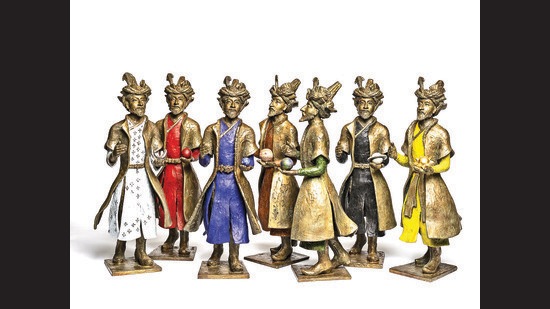
Although born in Kabul, the texture of Humayun’s daily life was steeped in the traditions of the land where he was eventually buried. The museum’s seven bronze Humayuns are sculpted by Scottish artist Jill Watson. Each Humayun is wearing the same ulbaqcha — a jacket that the emperor designed himself — but the robes are of different colours.
In Hindu astrological traditions, planets associated with a day of the week are worshipped as deities. To avail the benefits of the powers associated with the planets, Humayun matched the colour of his robes to correspond to the colour of the planet of the day. For instance, white (moon) was for Monday, and black (Saturn) was for Saturday. The day Humayun fatally slipped, he was on his library’s roof, waiting for a word from his mathematician, whom he had sent to observe the rise of Venus in order to set the most auspicious hour to take an administrative decision. Since he died on a Sunday, Humayun must have been wearing a golden robe.
.
The silver coin
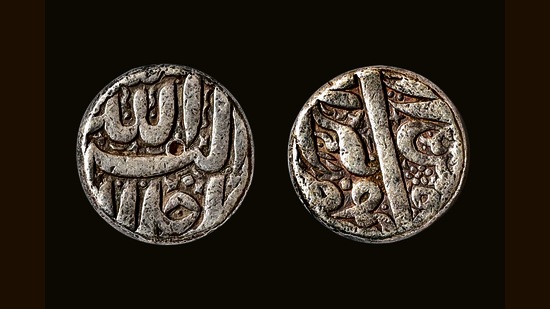
The silver rupee coin bears the Arabic inscription, “Allahu Akbar jallajalaluhu”. Flip it around, and it bears, in Persian, the word “Ram”. Minted during Akbar’s reign in Berar, which is in present-day Maharashtra, the coin is evidence of the Muslim-born ruler’s fascination for various faiths — a passion that led him to propound the spiritual system “Din-i-Ilahi”, or the religion of God. This aspect of Akbar is reflected in another exhibit — a much-faded 17th century Persian-language farman, or royal decree, issued by him, referring to scores of land allotments for the construction of temples.
.
The wooden canopy
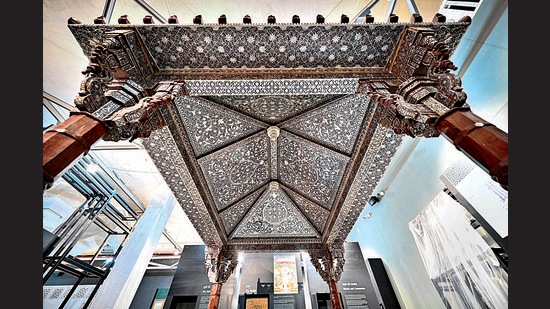
Age-old tradition does not let women enter Hazrat Nizamuddin’s small grave chamber. But the museum has an exact replica — not of the grave but of the grave chamber’s spectacular wooden canopy gifted by a Mughal noble from 17th century Bengal. It is inlaid in mother-of-pearl, ostensibly to mimic the starry effect of the night sky. A giant Tree of Life holds up each of the four corners of the canopy. In a sense, the museum’s spiritual core is this recreated canopy, simply because its original hangs over Nizamuddin’s grave. Had the saint’s grave not existed here, there would be no Sufi dargah at this place. And no Humayun’s Tomb.
.
The wall tiles
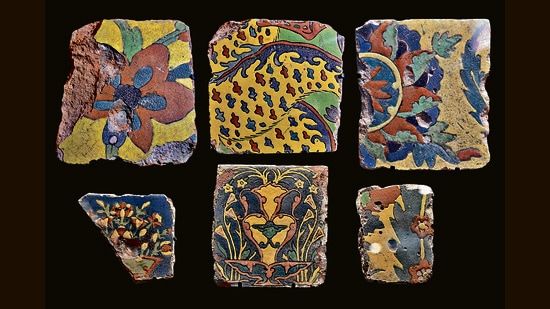
The golden vase looks fragile, as if could shatter at the touch. The vase exists as a drawing on a damaged tile and lies beside tiles of competing exquisiteness.
The 17th century Shahjahani tiles were recovered by Old Delhi’s illustrious Persian scholar, the late Yunus Jaffrey, from the Neeli Chatri monument at the foot of Salimgarh Fort, which stands beside the Red Fort. It was Humayun’s favoured riverside pavilion, where he would often look at the Yamuna, or read a book. The edifice still exists, without the tiles. Fortunately, a handful of Delhi’s monuments continue to hold on to their glazed tiles (plainer than the Shahjahani tiles), which are indicative of the Central Asian origins of the Mughals. Such tiles once adorned parts of Humayun’s Tomb, but most were lost by the 1950s, and were replaced with new tiles during the tomb’s restoration.
.
Chinese porcelain
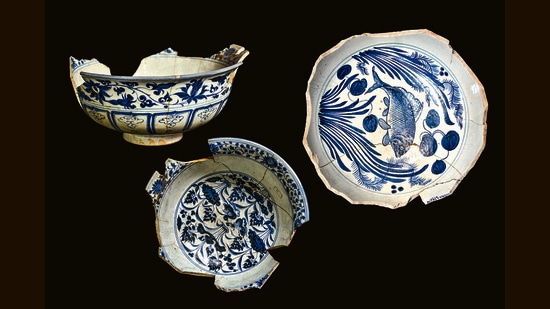
No Chinese takeaway existed in Mughal India. But Chinese crockery certainly did. The Mughal royalty had their daily meals in Chinese porcelain vessels, as confirmed in Emperor feasting with envoys (1598), one of the original paintings in the museum. The adjoining glass case displays four plates and two bowls. They were excavated decades ago from the ruins of Feroz Shah Kotla, outside the Walled City of Old Delhi. The plates had come via sea and land from the Yuan region of 14th-century China. The Delhi Tughlaks introduced porcelain on their dastarkhan (dining cloth/table), and the Mughals decided to keep that going. One plate has a blue fish painted on it (albeit with a hairline crack running through the fish’s head).
.
The large chhatri
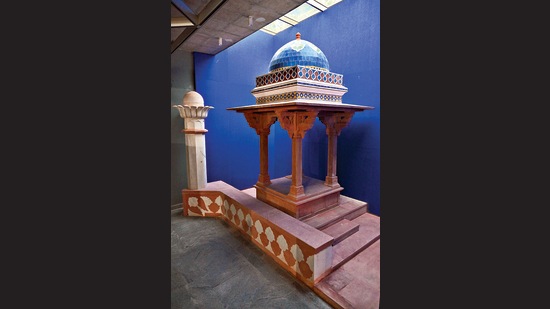
This piece is so massive that it is a monument in itself. This replica of the neck of the dome at Humayun’s Tomb is crafted of the same red sandstone, and built on the same scale as the real thing perched atop the mausoleum. Since the roof is inaccessible, this is the closest you can get to absorb its hugeness. The chhatri next to it is also a replica of the chhatris on the tomb’s roof. Since visitors will be allowed to climb this gigantic chhatri, it may be on its way to becoming one of Delhi’s most popular selfie spots.
.
The copper kalash

It stood for more than 400 years at the top of Humayun’s Tomb. Here, it stands inches away from your face — 18 ft tall, weighing 300 kg. This gilded finial, or kalash, shows the influence of Hindu temples on Mughal architecture. Several mandirs tend to be topped with a gold kalash. The tomb’s kalash, however, is made of copper, covered with layers of gold leaves. One evening in 2014, during a dust storm, it fell 70 ft, landing on the roof and crumbling into pieces. The mended kalash in the museum becomes even more precious because we know it has been salvaged from oblivion. Meanwhile, the orphaned dome received an exact replica of the original kalash. Perched atop the tomb, it shines at night — like it always did.
Read Also: the girl with the seven lives: read an exclusive excerpt from vikas swarup’s new book




